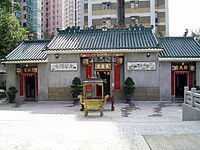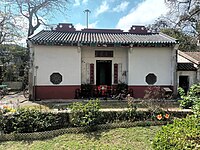There are several Hip Tin temples (Chinese: 協天宮; Jyutping: hip3 tin1 gung1) in Hong Kong. Kwan Tai (Guan Yu) is worshiped in these temples.
Kwan Tai temples are also dedicated to Guan Yu. Man Mo temples are jointly dedicated to Man Tai (文帝) and Kwan Tai (aka. Mo Tai, 武帝).
Note 1: A territory-wide grade reassessment of historic buildings is ongoing. The grades listed in the table are based on these updates [1] [2] (8 June 2023). The temples with a "Not listed" status in the table below are not graded and do not appear in the list of historic buildings considered for grading.
Note 2: While most probably incomplete, this list of Hip Tin temples is tentatively exhaustive.
| Location | Notes | Status | References | Photographs |
|---|---|---|---|---|
| Ma Wan Tsuen (馬環村), Lei Yue Mun (Kowloon) |
The Hip Tin Temple is adjacent to the Tin Hau Temple (鯉魚門天后廟) and was added after 1953.[1] | Grade III | [3] [4] Picture: Tin Hau Temple (left) and Hip Tin Temple (right). |
 |
| Shing Mun San Tsuen (錦田城門新村), Kam Tin, Yuen Long District |
Hip Tin Temple, Shing Mun San Tsuen The temple is owned by the Cheng clan. It was probably built around 1920.[2] It was relocated from Shing Mun Valley in the 1920s due to the construction of the Shing Mun Reservoir and the resulting resettlement of Shing Mun San Tsuen.[3] |
Nil grade | [5] [6] [7] [8] |  |
| Po Sam Pai (布心排), Plover Cove, Tai Po District |
Hip Tin Temple, Po Sam Pai Built in 1823. The temple was renovated in 1889 and 1905.[4] |
Grade III | [9] [10] [11] |  |
| No. 39 Ting Kok Road, Tai Po Kau Hui |
Tin Hau Temple, Tai Po Kau Hui (大埔舊墟天后宮) Built in 1691. On the left of the Tin Hau Temple is Hip Tin Temple. On its right was Tam Sin Temple (譚仙宮) where Tam Kung was revered.[5] The Tam Sin Temple was converted into a Shui Yuet Temple (水月宮) dedicated to Guanyin in the mid-2010s.[6] |
Grade III | [12] [13] [14] [15] [16] [17] |  |
| No. 53 Cheung Shue Tan (樟樹灘), Tai Po District |
Hip Tin Temple, Cheung Shue Tan (樟樹灘村協天宮) Its year of construction is unknown. The temple was renovated in 1898, 1910 and 1997.[7][8] |
Grade III | [18] [19] |  |
| Shuen Wan area of Plover Cove, next to Kei Shan Kok between Wai Ha and Ha Tei Ha, Tai Po District.[9] |
One of the three temples of the Sam Kung Temples complex (三宮廟). The other ones are a Tin Hau Temple and a Temple of Confucius.[9] The Sam Kung Temples complex had been destroyed by a typhoon in 1936 and was reconstructed in 2009.[10] | Not listed | [20] [21] |  |
| Po Tung Road (普通道), Sai Kung Town |
Tin Hau Temple and Hip Tin Temple (西貢墟天后古廟及協天宮) The two temples are believed to have been rebuilt in the 1910s to 1920s.[11] |
Grade II | [22] [23] [24] Picture: Tin Hau Temple (left) and Hip Tin Temple (right) in Sai Kung. |
 |
| No. 2 Lai Chi Wo, Sha Tau Kok |
Hip Tin Temple and Hok Shan Monastery Located on the square of Lai Chi Wo Village.[12] Built in the Qing dynasty, they have a history of more than two hundred years. The two structures are connected. They were jointly built by the seven villages in Sha Tau Kok, Hing Chun Yeuk (慶春約), for drawing good fortune and expelling the evils. Hip Tin Temple is for Guan Di in which there is a statue of Guan Di while Hok Shan Monastery is for Guan Yin. |
Grade III | [25] [26] [27] |  |
| Just opposite the Sha Tau Kok Control Point, Shan Tsui Tsuen (山咀), Sha Tau Kok |
Hip Tin Temple, Shan Tsui Tsuen Completed in 1895. It also has been used as a school.[13] |
Declared | [28] [29] [30] [31] |  |
| Kuk Po, Luk Keng, Sha Tau Kok |
Kai Choi School and Hip Tin Temple, Kuk Po[14] | Grade III | [32] [33] |  |
| Nam Chung Cheng Uk, Sha Tau Kok |
Hip Tin Temple, Nam Chung (南涌協天宮) | Not listed | [34] |  |
| Yim Tso Ha, Sha Tau Kok |
Hip Tin Temple, Yim Tso Ha (鹽灶下協天宮) | Not listed | [35] [36] |  |
| Wu Shek Kok, Sha Tau Kok |
Hip Tin Temple Adjacent to a Tin Hau Temple. |
Not listed | [37] [38] [39] Picture: Tin Hau Temple (left) and Hip Tin Temple (right). |
 |
See also
editReferences
edit- ^ Antiquities Advisory Board. Historic Building Appraisal. Tin Hau Temple, Ma Wan Tsuen, Lei Yue Mun
- ^ "Agreement No CE 31/99. Environmental Impact Assessment". Environmental Protection Department.
- ^ Antiquities Advisory Board. Historic Building Appraisal. Hip Tin Temple, Shing Mun San Tsuen
- ^ Antiquities Advisory Board. Introduction to 1444 Historic Buildings. Item #969 Archived 2016-03-04 at the Wayback Machine
- ^ Antiquities Advisory Board. Historic Building Appraisal. Tin Hau Temple, Tai Po Kau Hui
- ^ "(大埔北區)天后宮主持 致力宣揚道家文化". homemory.hk (in Chinese). 30 August 2020.
- ^ Antiquities Advisory Board. Historic Building Appraisal. Hip Tin Temple, Cheung Shue Tan
- ^ The Tai Po Book, p.40 Archived 2011-06-09 at the Wayback Machine
- ^ a b "Wong Wing Ho, "Towards Urbanisation: Shuen Wan and Plover Cove Reservoir", Tai Po Book p. 239" (PDF). Archived from the original (PDF) on 2009-07-18. Retrieved 2011-08-07.
- ^ "船灣三宮廟修復重光", The Sun, 7 December 2009 (in Chinese)
- ^ Antiquities Advisory Board. Introduction to 1444 Historic Buildings. Item #398 Archived 2016-03-04 at the Wayback Machine
- ^ Eco Association (Hip Tin Temple and Hok Shan Monastery) Archived 2009-09-10 at the Wayback Machine (in Chinese)
- ^ Antiquities Advisory Board. Introduction to 1444 Historic Buildings. Item #338 Archived 2016-03-04 at the Wayback Machine
- ^ Antiquities Advisory Board. Introduction to 1444 Historic Buildings. Item #1105 Archived 2016-03-04 at the Wayback Machine
Further reading
edit- Chan, Siu-po (2007). Guandi Cult in Hong Kong (Master of Arts Dissertation) (in Chinese). The University of Hong Kong.